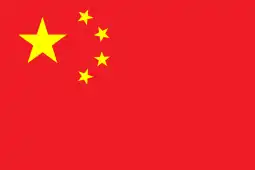Space Competitiveness Index
The Space Competitiveness Index (SCI) is a self-financed, independently researched, annual report that compares and ranks how countries invest in and benefit from space industry.[1] The report has been published annually since 2008 by Futron Corporation, a U.S. consulting firm.[2] The report has grown over the years from the top 10 leading space markets in 2008 to 15 in 2012. While the full reports are available for purchase, the executive summary is distributed freely.
Overview
Traditionally, the report included the top 10 leading market the s which included Brazil, Canada, China, Europe, India, Israel, Japan, Russia, South Korea, and the United States. In the 2012, the report introduced 5 more countries which include Argentina, Australia, Iran, South Africa, and Ukraine. The report treats Europe as integrated whole.
A set of over 40 metrics that have the greatest economic determinants are compiled for each entity individually. The metrics were separated into three major areas:
- Government
- Human Capital
- Industry
2008 SCI
The 2008 report was the first edition of the Space Competitiveness Index. The report ranked the top 10 global space participant countries across over 40 greatest economic determinants metrics.[3]
Total Aggregate Scores by Country:
 United States 91.43
United States 91.43 Europe 48.07
Europe 48.07 Russia 34.06
Russia 34.06 China 17.88
China 17.88 India 17.52
India 17.52.svg.png.webp) Canada 16.94
Canada 16.94 Japan 14.46
Japan 14.46 South Korea 8.89
South Korea 8.89 Israel 8.38
Israel 8.38 Brazil 4.96
Brazil 4.96
2009 SCI
The second edition of the report was able to contrast with the first edition. While the United States still led the index, they declined marginally based on increase by other countries.
Total Aggregate Scores by Country:
 United States 90.32 (
United States 90.32 ( )
) Europe 46.81 (
Europe 46.81 ( )
) Russia 32.44 (
Russia 32.44 ( )
) Japan 21.17 (
Japan 21.17 ( 3)
3) China 19.46 (
China 19.46 ( 1)
1).svg.png.webp) Canada 18.13 (
Canada 18.13 ( )
) India 15.33 (
India 15.33 ( 2)
2) South Korea 12.04 (
South Korea 12.04 ( )
) Israel 8.7 (
Israel 8.7 ( )
) Brazil 7.09 (
Brazil 7.09 ( )
)
2010 SCI
The 3rd edition continued to show decline from the dominant players and increase from the smaller countries.[4] The report found that countries such as the U.S. and Canada has its technological leadership buoyed by the contribution of the industrial sector, which effectively markets, uses, and sells technology assets to government and commercial clients worldwide.[5] Conversely, other countries such as China do not effectively leverage its high space technology achievement capability. some of the factors that influence that are government commercial policy and a limited private-sector industrial activity.
Total Aggregate Scores by Country:
 United States (
United States ( )
) Europe (
Europe ( )
) Russia (
Russia ( )
) Japan (
Japan ( )
).svg.png.webp) Canada (
Canada ( 1)
1) India (
India ( 1)
1) South Korea (
South Korea ( 1)
1) China (
China ( 3)
3) Israel (
Israel ( )
) Brazil (
Brazil ( )
)
2011 SCI
In the 2011, while global activity overall increase, the dominant players continued to decrease for the fourth straight year as middle-tier nations ascend.[6]
2012 SCI
The 2012 report marks the fifth anniversary edition of the study, which called for a half-decade review of international space trends based on quantitative and qualitative data.[7] In the 2012 report, in addition to the 10 traditional leading markets, Futron included a second tier for emerging space leaders. The new tier, which is evaluate alongside the 10 original markets include Argentina, Australia, Iran, South Africa, and Ukraine. Brazil being surpassed by Australia. While the US remains the overall leader in space competitiveness its relative position has fallen for the fifth straight year as other countries enhance their capabilities. In contrast, other countries such as China, Japan, Russia and India have improved their space competitiveness by 41 percent, 37, 11 and 10 percent respectively since the first edition of the Space Competitiveness Index.[8]
Total Aggregate Scores by Country:
 United States 99.67
United States 99.67 Europe 50.11
Europe 50.11 Japan 48.76
Japan 48.76 Russia 45.29
Russia 45.29 China 41.85
China 41.85.svg.png.webp) Canada 39.10
Canada 39.10 India 28.64
India 28.64 South Korea 15.22
South Korea 15.22 Israel 9.30
Israel 9.30.svg.png.webp) Australia 5.22
Australia 5.22
References
- "2011 Space Competitiveness Index: India Overtakes Canada". The Huffington Post. Retrieved 21 December 2013.
- "Space Competitiveness Index (SCI)". Futron Corporation. Archived from the original on 24 December 2013. Retrieved 21 December 2013.
- "INSIGHT: The Futron Space Competitiveness Index". Sat Magazine. Retrieved 22 December 2013.
- "U.S. Space Edge Erodes, Non-Traditional Players Ascend, and Competition Intensifies: Futron Announces 2010 Space Competitiveness Index Trends". MobilityTechzone. Retrieved 22 December 2013.
- Messier, Doug. "Futron Report: America, Canada Do Well in Optimizing Space Technology, China Hindered". Parabolic Arc. Retrieved 22 December 2013.
- "Futron Corp. Releases Its 2011 Space Competitiveness Index". Moon And Back Media LLC. Retrieved 22 December 2013.
- "Futron Corporation Announces Results of Fifth Annual Space Competitiveness Index". PRWeb. Retrieved 21 December 2013.
- "India has improved space competitiveness by 10 percent". The Hindu. Retrieved 22 December 2013.